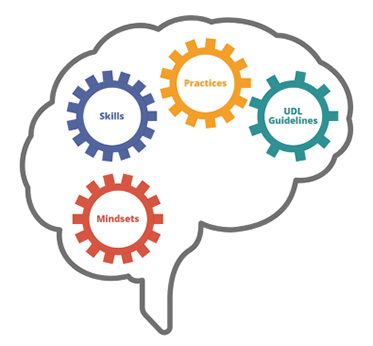The Steps to Inclusion: How UDL Helps
The inclusion of students with disabilities in the general education environment has been shown to benefit both learners with disabilities (Cole, Murphy, Frisby, Grossi & Bolte, 2021), and students without disabilities (Katz & Mirenda, 2002). Unfortunately, it is still not the experience of many learners with disabilities. The barriers to inclusion are plentiful. They include the mindsets, skills, and practices of the educators around those learners, but there are also educators who are solidly working toward including every learner. Some, like Sara Lucero from episode 98, are using Universal Design for Learning (UDL) as a tool to make inclusion possible.
What does it mean to use UDL as a tool for inclusion? Isn’t UDL just a graphic organizer with three columns, each named for one of the principles?

As people around the world have been applying UDL, most recognize that there is more to UDL which means there are more opportunities to build inclusive environments. Inclusion is a cornerstone of UDL. Originally, the framework was created to help educators understand what they could do in their lessons and learning environments to ensure more and more students could become part of those environments (Rose & Meyer, 2002).
During episode 98, Principal Lucero shares how she moved her school toward inclusion. She began that journey by looking for straightforward barriers that prevented students from being present in the general education environment. She found a point system that was counteractive. It kept students from participating rather than incentivizing them to participate. She was looking for skill barriers. For example, the teachers used a skillset to design that system, but that skillset was counter to inclusion. They needed help to learn new skills. She looked for mindset barriers. For example, the mindset was a readiness model – students had to show that they were ready to be included rather than learning new behaviors alongside their peers in the inclusive setting. She looked for practice barriers. For example, readiness was woven into the practices of those teachers. That practice ruled what skills were used. She knew that the staff of Olympic View Elementary School needed to understand what skills, mindsets, and practices aligned with UDL and would help them use the suggested practices in the Guidelines. While she didn’t have the full list in front her, you do! Those mindsets, skills and practices are laid out in The UDL Gears.

Nelson, L. L. (2023, May 24). The UDL Gears.
https://theudlapproach.com/theudlgears
Whether you use the hover graphic, open the PDF or the EPUB, you can quickly access the skills, mindsets, and practices educators across the globe use to apply the UDL Guidelines in their environments. Each of the gears has a set of cogs along the edges. Each cog identifies a skill, mindset, or practice you or your staff can use to move toward designing inclusive environments. Use this information to examine your own environment. What exists in your environment? What are you still working toward in your environment? Where do you see gaps in your environment? By knowing what you should look for, you know what to work on. By clarifying that journey, all staff can be on the same pathway that works to value all learners as expert learners.
References
Cole, S. M., Murphy, H. R., Frisby, M. B., Grossi, T. A., & Bolte, H. R. (2021). The Relationship of Special Education Placement and Student Academic Outcomes. The Journal of Special Education, 54(4), 217–227. https://doi.org/10.1177/0022466920925033
Katz, J., & Mirenda, P. (2002). Including students with developmental disabilities in general education classrooms: Educational benefits. International journal of special education, 17(2), 14-24.
Rose, D. H., & Meyer, A. (2002). Teaching every student in the digital age: Universal Design for Learning. ASCD.
